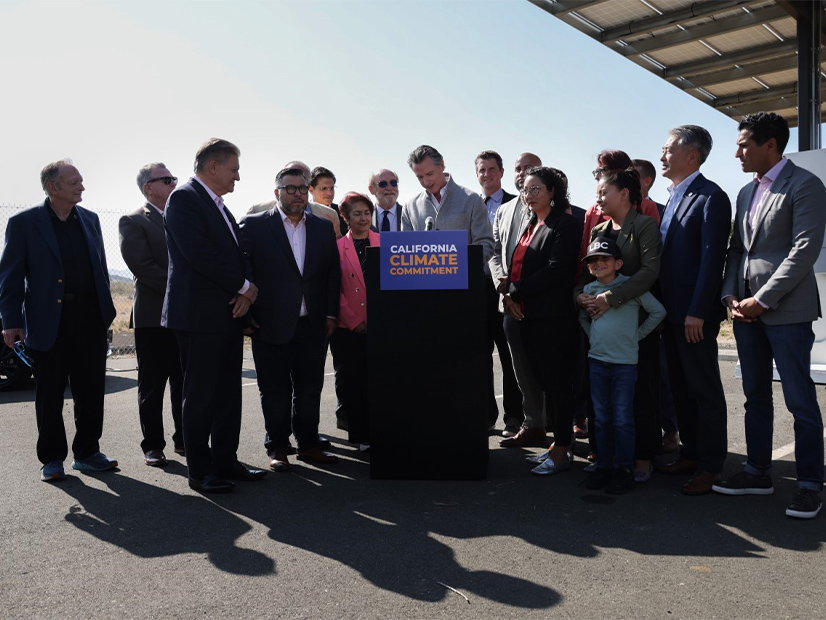
A half-dozen new climate and energy laws took effect in California on Jan. 1, including measures to promote carbon capture and sequestration, establish emissions reduction and clean energy targets, and instruct the state’s three major energy agencies to expand their long-term generation and transmission planning horizons.
On the clean energy front, Senate Bill 1020 establishes new state goals of using 90% carbon-free electricity by 2035 and 95% by 2040 as steps on the way to supplying retail customers with 100% clean energy by 2045, as required by 2018’s Senate Bill 100. The bill was developed last year by the Senate Climate Working Group.
“Senate Bill 1020 is our collective victory in equipping California to meet the urgent challenges of climate change, adaptation and resiliency through an equitable lens,” Sen. John Laird, who authored the measure, said in a news release when Gov. Gavin Newsom signed it in September. “We cannot afford to wait for a better time for progress, and the accelerated goals established in SB 1020 reflect this urgency.”
Another key measure, Assembly Bill 1279, codified a 2018 executive order by former governor Jerry Brown that originated the state’s goal of achieving carbon neutrality by 2045. The legislation also requires the state to reduce greenhouse gas emissions at least 85% below 1990 levels by 2045 and instructs the California Air Resources Board (CARB) to report to the legislature on the “feasibility and tradeoffs” of achieving the bill’s goals.
Carbon Capture
Several laws that took effect in the new year aim to advance carbon capture and sequestration (CCS) as viable means of reducing greenhouse gasses.
Senate Bill 905 directs CARB to establish a regulatory framework for carbon capture and storage technologies to prevent CO2 from entering the atmosphere and to trap it underground. In its 2022 scoping plan, CARB said the state should use the technologies as a way to meet emission reduction goals, though no such projects currently exist in California.
“Carbon capture and sequestration will be a necessary tool to reduce GHG emissions and mitigate climate change while minimizing leakage and minimizing emissions where no technological alternatives may exist,” the CARB plan said.
The measure also requires CARB to develop a streamlined permitting process by 2025 that evaluates seismic, environmental and air-quality risks, and to create a public database that tracks the development of CCS projects statewide.
Assembly Bill 1757 tasks the state Natural Resources Agency with establishing ambitious carbon sequestration targets for “natural and working lands” by Jan. 1, 2024.
“The state’s forests, agricultural lands, rangelands, wetlands, oceans, and other natural and working landscapes define the beauty and well-being of our state, but tragically are suffering increasing degradation caused by a changing climate,” the measure says.
The Natural Resources Agency has until Jan. 1, 2024, to create a plan with specific CO2 reduction goals for 2030, 2038 and 2045 and to establish an expert advisory committee to “inform and review modeling and analyses for natural and working lands [and] to advise state agencies on implementation strategies.”
In addition, the act requires CARB to determine “standard methods for state agencies to consistently track greenhouse gas emissions and reductions, carbon sequestration, and, where feasible and in consultation with the Natural Resources Agency and the Department of Food and Agriculture, additional benefits from natural and working lands over time.”
Senate Bill 1314 prohibits captured CO2 from being injected into oil wells for “enhanced oil recovery,” or EOR, as a way to extract remaining oil.
EOR isn’t widely used in California, but injection of CO2 and other gasses “accounts for nearly 60% of EOR production in the United States,” according to the U.S. Department of Energy. Increased carbon capture could expand the practice, it said.
“The legislature finds and declares that the purpose of carbon capture [and sequestration] technologies … is to facilitate the transition to a carbon-neutral society and not to facilitate continued dependence upon fossil fuel production,” the bill says.
Transmission Planning
Several transmission planning bills faltered or were heavily water down in 2022.
One that passed mostly intact was SB 887. It directs CAISO, the California Public Utilities Commission and the state Energy Commission to expand their generation and transmission planning horizons from the current 10 years to “at least 15 years … to ensure adequate lead time for [CAISO] to analyze and approve transmission development and for the permitting and construction of the approved facilities.”
CAISO already performs a 20-year transmission outlook, but it is a long-term conceptual plan of grid needs, including out-of-state projects, intended to complement but not replace the ISO’s 10-year transmission planning process, which concerns only in-state projects.
Becker’s bill instructed CAISO to identify “the highest priority transmission facilities that are needed to allow for reduced reliance on [fossil fuel] resources in transmission-constrained urban areas by delivering renewable energy resources or zero-carbon resources that are expected to be developed by 2035 into those areas.”
